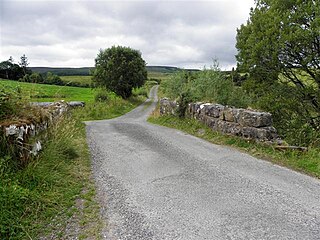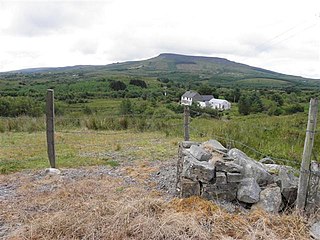
Mullanacre Upper is a townland in the Parish of Tomregan, Barony of Tullyhaw, County Cavan, Ireland.
Moneensauran is a townland in the civil parish of Templeport, County Cavan, Ireland. It lies within the Roman Catholic parish of Glangevlin and barony of Tullyhaw.
Cloncurkney is a townland in the civil parish of Templeport, County Cavan, Ireland. It lies in the Roman Catholic parish of Templeport and barony of Tullyhaw.
Altnadarragh is a townland in the civil parish of Templeport, County Cavan, Ireland. It lies in the Roman Catholic parish of Corlough and barony of Tullyhaw.
Ardvagh is a townland in the civil parish of Templeport, County Cavan, Ireland. It lies in the Roman Catholic parish of Corlough and barony of Tullyhaw.
Corranierna (Corlough) is a townland in the civil parish of Templeport, County Cavan, Ireland. It lies in the Roman Catholic parish of Corlough and barony of Tullyhaw.

Lannanerriagh is a townland in the civil parish of Templeport, County Cavan, Ireland. It lies in the Roman Catholic parish of Corlough and barony of Tullyhaw.
Altshallan either Alt Sealáin, meaning The Gorge of the Water Channel or Alt Sealán meaning the Height of the Gallows, is a townland in the civil parish of Templeport, County Cavan, Ireland. It lies in the Roman Catholic parish of Glangevlin and barony of Tullyhaw.

Bellavally Lower, is a townland in the civil parish of Templeport, County Cavan, Ireland. The local pronunciation is Bealbally. It lies in the Roman Catholic parish of Glangevlin and barony of Tullyhaw.
Bursan, in Gaelic 'Bus-an' possibly meaning The Little Mouth, is a townland in the civil parish of Templeport, County Cavan, Ireland. It lies in the Roman Catholic parish of Glangevlin and barony of Tullyhaw.

Curraghglass, an Anglicisation of the Gaelic, ‘Currach Glas’ meaning The Green Moor, is a townland in the civil parish of Templeport, County Cavan, Ireland. It lies in the Roman Catholic parish of Glangevlin and barony of Tullyhaw.

Derrynananta Lower, an Anglicisation of the Gaelic, ‘Doire na Neannta Íochtar’, meaning The Lower Oak-wood of the Nettles, is a townland in the civil parish of Templeport, County Cavan, Ireland. It lies in the Roman Catholic parish of Glangevlin and barony of Tullyhaw.

Derrynananta Upper, an Anglicisation of the Gaelic, ‘Doire na Neannta Uachtarach’, meaning The Upper Oak-wood of the Nettles, is a townland in the civil parish of Templeport, County Cavan, Ireland. The townland lies in the Roman Catholic parish of Glangevlin and barony of Tullyhaw. In the 19th century, it was also known as Derrynananta Lodge, after a shooting-lodge there called Glengavlen Lodge, which was owned by John Cole, 2nd Earl of Enniskillen.

Derrynatuan, an Anglicisation of the Gaelic, either ‘Doirín an tSuain’, meaning The Little Oak-wood of the Rest or Sleep, or ‘Doire na Tóin’, meaning The Oak-wood of the Low Lying Land, or ‘Doire na Tamhan’, meaning The Oak-wood of the Tree-Stumps, is a townland in the civil parish of Templeport, County Cavan, Ireland. It lies in the Roman Catholic parish of Glangevlin and barony of Tullyhaw.

Drumhurrin, an Anglicisation of the Gaelic ‘Droim Shoirn’, meaning The Hill-Ridge of the Lime-Kiln or Furnace, is a townland in the civil parish of Templeport, County Cavan, Ireland. It lies in the Roman Catholic parish of Glangevlin and barony of Tullyhaw.
Legatraghta, an Anglicisation of the Gaelic ‘Lag an tSneachta’, meaning The Hollow of the Snow, is a townland in the civil parish of Templeport, County Cavan, Ireland. It lies in the Roman Catholic parish of Glangevlin and barony of Tullyhaw.
Legglass, an Anglicisation of the Gaelic, ‘Lag Glas’, meaning The Green Hollow is a townland in the civil parish of Templeport, County Cavan, Ireland. It lies in the Roman Catholic parish of Glangevlin and barony of Tullyhaw.

Legnaderk, an Anglicisation of the Gaelic, either ‘Lag na Deirce’, meaning The Hollow of the Cave or 'Lag na Dearg', meaning The Hollow of the Blood or 'Lag nÁtha Dheirg', meaning The Hollow of the Red Ford, is a townland in the civil parish of Templeport, County Cavan, Ireland. It lies in the Roman Catholic parish of Glangevlin and barony of Tullyhaw.
Mully Lower, an Anglicisation of the Gaelic, ‘Mullach Íochtar’ meaning The Lower Summit of the Hill, is a townland in the civil parish of Templeport, County Cavan, Ireland. It lies in the Roman Catholic parish of Glangevlin and barony of Tullyhaw.

Tullynacross, an Anglicisation of the Gaelic, ‘Tulaigh na Croise’ meaning The Hill of the Cross, is a townland in the civil parish of Templeport, County Cavan, Ireland. It lies in the Roman Catholic parish of Glangevlin and barony of Tullyhaw.











